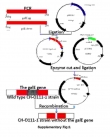Development and efficacy evaluation of a SP01-adjuvanted inactivated Escherichia coli mutant vaccine against bovine coliform mastitis
Abstract
Objective: Escherichia coli (E. coli) is one of the most common pathogens causing clinical mastitis in cattle, and there is no available vaccine to prevent this disease in China; therefore, there is an urgent need to develop an E. coli vaccine against bovine clinical mastitis.
Methods: the candidate vaccine (Ch-O111-1) and challenge (LZ06) strains were screened from the milk samples of the cows with clinical mastitis. Furthermore, to extend the cross-protection of the Ch-O111-1 strain, the galE gene fragment of the Ch-O111-1 strain was deleted by homologous recombination between the Ch-O111-1 strain and pCVD442/△galE plasmid, which was identified by the conventional methods, including PCR, SDS-PAGE and sequencing. The Ch-O111-1/ΔgalE (Z9) strain was characterized by extensive cross-reactivity and attenuated virulence, and we prepared inactivated Z9 vaccines with different adjuvants.
Results: Immunization of inactivated Z9 antigen induced adjuvant-, dosage-, inoculation times-dependent antibody titers in cows and mice. Furthermore, immunization with SP01-adjuvanted inactivated Z9 vaccine protected cows from LZ06 caused severe clinical mastitis and mice from LZ06 caused death.
Conclusion: SP01-adjuvanted inactivated Z9 vaccine was successfully developed, which could protect the cows from Escherichia coli caused severe mastitis.


